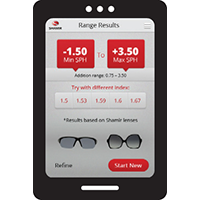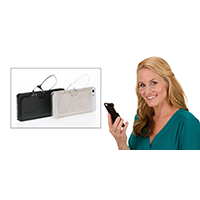EXAMS / DISPENSING
ZeaVision Introduces QuantifEye MPS II Macular Pigment Screener

More Images |
Top Line: ZeaVision, the parent company of EyePromise nutraceuticals is introducing the QuantifEye MPS II macular pigment screener.
Close Up: Doctors can now measure a patient’s Macular Pigment Optical Density (MPOD) with more ease and less time with ZeaVision’s newly-released QuantifEye MPS II. The instrument, an update from the original QuantifEye measurement device, is the next generation in macular pigment measurement to help identify patients with low MPOD, a key risk factor for Age-related Macular Degeneration (AMD). The original QuantifEye, which debuted in 2006, has been scientifically validated for accuracy and repeatability in numerous clinical research studies. More than four million eyes have been accurately measured by the QuantifEye instrument since market introduction, according to ZeaVision. The new QuantifEye MPS II enhances the accuracy and reliability of the original QuantifEye instrument with significant software advancements that benefit the patient and optometric practice. The new technology is currently being installed in eyecare practices across the nation. A growing body of scientific evidence proves diet and supplementation of the antioxidants Zeaxanthin and lutein can protect and enhance vision by increasing MPOD. These macular pigments, which are found in the back of the eye, filter the harmful blue light part of the light spectrum to protect the photo-receptors.
Vital Stats: According to the National Eye Institute’s Age-related Eye Disease Study 2 (AREDS 2) clinical trial, a national five-year, FDA-sponsored study, adding Lutein and dietary Zeaxanthin to the original AREDS formula resulted in a 26 percent incremental reduction in the progression to advanced AMD in subjects with the lowest intake of dietary Zeaxanthin and Lutein (most of the population within the U.S.). Daily supplementation of dietary Zeaxanthin and Lutein also slowed the progression to advanced AMD in all AREDS 2 participants by an additional 10 percent over the original AREDS formula alone.
www.zeavision.com; (866) 833-2800
|
|
| Top | |
| Send your comments to VM |
WEB TECH
Shamir Launches New Frame and Rx Lens Compatibility App

|
Top Line: Shamir is launching its latest App, Shamir Arch. Now available on Android devices, Shamir Arch allows ECPs to easily and immediately identify whether or not a chosen frame will work with their patient’s prescription.
Close Up: The Shamir Arch app is a free app that allows ECPs to determine if a specific prescription will fit in a chosen frame. Previously, ECPs would have to call their lab to answer this question, but the Arch app allows ECPs the convenience of finding out immediately, while the patient is still in the office. Arch app users can simply enter the frame parameters, the patients PD and the lens material and Arch then provides the Rx range for the frame based on the given parameters. Arch also allows users to change the parameters to suit the patient’s needs. For instance, ECPs are able to change the lens materials to see how the prescription range changes, so they are able to offer different options to the patient.
“With the launch of our latest X3 sunwear package, we recognize that many ECPs want to prescribe Rx lenses in various sun frames for their patients and need to be able to tell them whether or not their chosen frame will work with their prescription. With the Arch app, ECPs can now enter the necessary information and receive an immediate answer. They can also experiment with the app. For instance, if the patient is set on a certain frame, they may be able to prescribe an alternate material, so they can use the frame they prefer,” said Mark Becker, vice president of strategic partnerships and marketing. “We know this app will make it easier than ever for ECPs to prescribe sunwear,” added Becker.
Arch is designed for use with the Shamir Attitude lens design; ECPs will be able to select the progressive or single vision design.
Vital Stats: The Arch App is available through Google Play for Android users. It is scheduled to be available by November 1st through the App store. The app is currently available for Android devices and will be available for iOS devices in October 2014. Shamir is also working on a desktop version which is schedule to launch by the end of 2014. The app is free, users simply to need to register and create a login to use the app. The range provided by the Arch App is an approximate range, so for Rx’s that are near the given range, the ECP should contact the lab to inquire if a wider range is available.
www.shamirlens.com; (877) 514-8330
| Top | |
| Send your comments to VM |
TOOLS / SUPPLIES
ThinOptics Puts Readers on the Back of A Smart Phone, So They Are ‘Always With You’

More Images |
Top Line: ThinOptics is launching a complete range of readers to fit on the back of popular smart phones from Apple and Samsung, as well as on a Universal Pod that will fit in a pocket or purse, or attach to the back of most smart phones, e-readers, tablet computers or any device with a hard, flat surface.
Close Up: "Glasses were invented in the middle ages, but for the last 600 years, no one had figured out how to keep people from forgetting their glasses—until now," said David Chute, co-founder and general manager of ThinOptics, a Palo Alto, Calif. startup that puts readers on the back of smart phones.
"Most people who use reading glasses own about eight pairs that are scattered all over their homes and offices. These conventional reading glasses are frequently not available when most people are out of their home or office, which makes high resolution smart phones difficult to use. It's also nearly impossible to read anything small such as menus, labels and shopping lists. The one thing that most people always carry with them is their smart phone. By putting readers on the back of their phone, the problem of lost or forgotten readers is solved forever," said Chute.
"ThinOptics can fit on a smart phone because they compress to the size and width of a credit card, weigh less than a nickel, are durable enough to bend thousands of times and designed to fit comfortably and securely on the user's nose" said Chute, adding that the readers are designed to fit noses of all shapes and sizes.
Chute said ThinOptics tested its readers at several types of eyecare practices, including a contact lens practice, an ophthalmologist’s practice, and a practice with an optometrist and a dispenser. “Each practice has consistently sold between two to three readers per week over the last six months for an annualized sell through of between 100 to 150 readers per location," he reported.
Vital Stats: ThinOptics are available in two colors (black and clear), in three powers (+1.50D; +2.00D; +2.50D); and are available in cases that fit the iPhone 4/4s; iPhone 5/5s; iPhone 5c; the Galaxy S4 and a Universal Pod that will fit in a pocket or purse, or attach to virtually any smart phone or hard flat surface using double sided adhesive tape. ThinOptics will be available for the iPhone 6 and 6+ in mid-November.
The Apple and Samsung phone cases and readers retail for $38.95. The Universal Pod retails for $24.95. Wholesale prices are 50 percent off retail. ThinOptics has implemented a Minimum Advertised Pricing policy to insure that all retailers compete on a level playing field.
ThinOptics is building a sales team of Territory Sales Representatives to represent the company in the U.S. optical channel.
Click here to see a video about ThinOptics readers.
www.thinoptics.com (consumer website); www.dealer.thinoptics.com (dealer website); (888) 484-4667
| Top | |
| Send your comments to VM |
